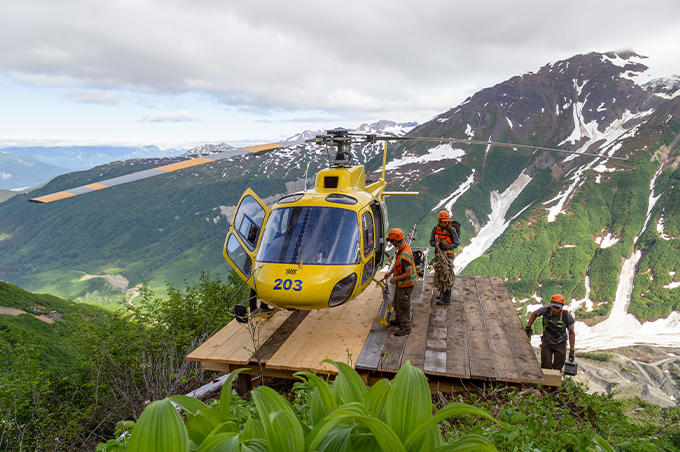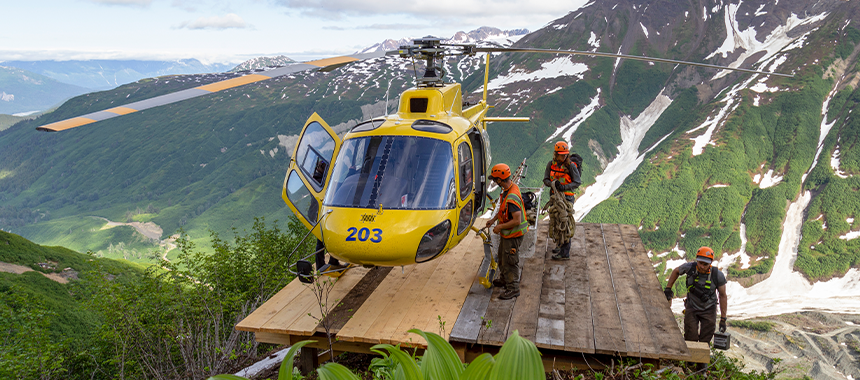The New Manifest Destiny


Image courtesy of American Pacific
Apart from numerous Native American tribes like the Yaqui, Hopi, Ute, and Washoe, mineral explorers were some of the first to settle the Western US. As the country expanded, the West emerged as a vast, uncharted frontier, offering a new horizon for those daring enough to venture into its rugged landscapes. The region became a symbol of possibility—a place where the bold could carve out their fortunes from the untapped riches buried beneath the earth. The allure of the West was about the prospect of discovering gold, silver, and other precious metals that lay hidden in the mountains and valleys, waiting to be unearthed by those with the grit and determination to find them.
In 1890, the Census Bureau declared the Western frontier closed. 134 years later, the Western US has become a new symbol of possibility for explorers: an untapped, mineral rich region with the ability to supply the ever-demanding globe.
The Western US’s complex tectonic history, marked by subduction zones, volcanic activity, and crustal stretching, created the perfect conditions for the formation of mineral deposits. Many copper deposits in the West are porphyry copper deposits, formed from hydrothermal fluids related to the cooling of magma deep within the Earth’s crust. Over millions of years, these fluids moved through fractures in the rock, depositing copper and other valuable metals like molybdenum and gold as they cooled. The result is vast, low-grade but highly concentrated deposits of copper, such as those found in Arizona’s Morenci and Bingham Canyon mines. These deposits are so large and rich in copper that they have sustained mining operations for over a century, making them some of the most important sources of copper in the world.
Copper
Porphyry deposits, while typically characterized by evenly distributed mineralization, can exhibit unique geological variations that influence their economic viability.For example, the CuMo deposit in Idaho, a hard rock copper porphyry, presents a distinctive stockwork system. “The nature of our orebody provides significant opportunities to lower CapEx. Unlike typical porphyrys where mineralization is evenly distributed throughout the ore body, our deposit has thin, finger-width veins containing the bulk of the copper, molybdenum, rhenium, and tungsten minerals,” said Andrew Brodkey, chief operating officer at Idaho Copper.
A key aspect of these porphyry systems is the presence of breccias—rock formations composed of broken fragments cemented together by a fine-grained matrix. Breccias, formed by intense hydrothermal activity, serve as both hosts and conduits for mineralizing fluids. As these fluids traveled through the fractured rock, they deposited copper and other metals, potentially creating zones of higher-grade mineralization within the broader porphyry system. At Faraday’s Copper Creek newly discovered at surface breccia are enhancing the economics of the deposit, said Paul Harbidge, president and CEO at Faraday Copper: “The first new target we drilled, Area 51, has resulted in the discovery of a cluster of breccias exposed at surface with strong copper mineralization. Assay results include: 1.29% copper over 11.36 meters within 45.75 meters at 0.48% copper.”
Lithium
There are two types of lithium deposits in the Western US: brine and clay-rich sedimentary deposits. Clay-rich sedimentary deposits form from the weathering of lithium-rich volcanic rocks. In large volcanic calderas or sedimentary basins, volcanic ash and pyroclastic materials accumulate and alter over time into clay minerals. Lithium, released during weathering or hydrothermal alteration, is incorporated into these clays, with the depositional environment concentrating the lithium through sedimentation and chemical processes. Jindalee Lithium’s McDermitt project is hosted in the volcanic caldera, a major benefit according to Ian Rodger, the CEO: “Lithium sedimentary deposits are the copper porphyries of the lithium world—huge, low-grade, generational assets. Our deposit is unique in that it outcrops at the surface, and the rock is very soft, so no blasting or grinding is required. Mining will be very cheap and we expect the waste-to-ore ratio to be around 1.”
The shift has been gradual, but remains beneficial in Clayton Valley said Steve Hanson, president and CEO of ACME Lithium: “The region has a history of lithium production since 1966, offering valuable infrastructure like roads, power, and a skilled workforce. The proximity to Albemarle’s operation means we are not starting from scratch—there is already community and employment support for lithium production.”
Tim Fernback, president and CEO of Grid Battery Metals, agrees: “Nevada’s robust infrastructure and emerging lithium resources present excellent opportunities for advancing mining projects and maximizing shareholder returns.”
Manifest destiny’s legacy
In 1872, the United States government formalized the opportunity to exploit the US’s geological riches through the mining law, a piece of legislation that opened the doors to the mineral resources on public lands. Anyone who could find valuable minerals could stake a claim. The mining law reflected the broader spirit of the time, a period when the nation was focused on growth, expansion, and the harnessing of its natural resources. The law is still in effect and “is old and complicated,” emphasized Chris Summers, CFO of Burgex Mining Consultants.
Claims are also no longer free, continued Summers: “The basic maintenance fee has gone up from US$165 to US$200 per claim, which is significant when multiplied by thousands of claims. We are already seeing companies not renewing claims due to the fee increase. While the BLM is mandated to review fees every five years, the magnitude of this year’s increase is significant. It is disheartening because we need this investment for the US to achieve its goals, particularly for the green energy transition.”
This new chapter in exploration history is not just about conquering the land, but about responsibly harnessing its resources to build a more sustainable and self-reliant future for the United States. The stakes are high, but so too is the potential for a new kind of prosperity—one that respects both the land and the legacy of those who first ventured westward.

Image courtesy of American Pacific
Apart from numerous Native American tribes like the Yaqui, Hopi, Ute, and Washoe, mineral explorers were some of the first to settle the Western US. As the country expanded, the West emerged as a vast, uncharted frontier, offering a new horizon for those daring enough to venture into its rugged landscapes. The region became a symbol of possibility—a place where the bold could carve out their fortunes from the untapped riches buried beneath the earth. The allure of the West was about the prospect of discovering gold, silver, and other precious metals that lay hidden in the mountains and valleys, waiting to be unearthed by those with the grit and determination to find them.
In 1890, the Census Bureau declared the Western frontier closed. 134 years later, the Western US has become a new symbol of possibility for explorers: an untapped, mineral rich region with the ability to supply the ever-demanding globe.
The Western US’s complex tectonic history, marked by subduction zones, volcanic activity, and crustal stretching, created the perfect conditions for the formation of mineral deposits. Many copper deposits in the West are porphyry copper deposits, formed from hydrothermal fluids related to the cooling of magma deep within the Earth’s crust. Over millions of years, these fluids moved through fractures in the rock, depositing copper and other valuable metals like molybdenum and gold as they cooled. The result is vast, low-grade but highly concentrated deposits of copper, such as those found in Arizona’s Morenci and Bingham Canyon mines. These deposits are so large and rich in copper that they have sustained mining operations for over a century, making them some of the most important sources of copper in the world.
Copper
Porphyry deposits, while typically characterized by evenly distributed mineralization, can exhibit unique geological variations that influence their economic viability.For example, the CuMo deposit in Idaho, a hard rock copper porphyry, presents a distinctive stockwork system. “The nature of our orebody provides significant opportunities to lower CapEx. Unlike typical porphyrys where mineralization is evenly distributed throughout the ore body, our deposit has thin, finger-width veins containing the bulk of the copper, molybdenum, rhenium, and tungsten minerals,” said Andrew Brodkey, chief operating officer at Idaho Copper.
A key aspect of these porphyry systems is the presence of breccias—rock formations composed of broken fragments cemented together by a fine-grained matrix. Breccias, formed by intense hydrothermal activity, serve as both hosts and conduits for mineralizing fluids. As these fluids traveled through the fractured rock, they deposited copper and other metals, potentially creating zones of higher-grade mineralization within the broader porphyry system. At Faraday’s Copper Creek newly discovered at surface breccia are enhancing the economics of the deposit, said Paul Harbidge, president and CEO at Faraday Copper: “The first new target we drilled, Area 51, has resulted in the discovery of a cluster of breccias exposed at surface with strong copper mineralization. Assay results include: 1.29% copper over 11.36 meters within 45.75 meters at 0.48% copper.”
Lithium
There are two types of lithium deposits in the Western US: brine and clay-rich sedimentary deposits. Clay-rich sedimentary deposits form from the weathering of lithium-rich volcanic rocks. In large volcanic calderas or sedimentary basins, volcanic ash and pyroclastic materials accumulate and alter over time into clay minerals. Lithium, released during weathering or hydrothermal alteration, is incorporated into these clays, with the depositional environment concentrating the lithium through sedimentation and chemical processes. Jindalee Lithium’s McDermitt project is hosted in the volcanic caldera, a major benefit according to Ian Rodger, the CEO: “Lithium sedimentary deposits are the copper porphyries of the lithium world—huge, low-grade, generational assets. Our deposit is unique in that it outcrops at the surface, and the rock is very soft, so no blasting or grinding is required. Mining will be very cheap and we expect the waste-to-ore ratio to be around 1.”
The shift has been gradual, but remains beneficial in Clayton Valley said Steve Hanson, president and CEO of ACME Lithium: “The region has a history of lithium production since 1966, offering valuable infrastructure like roads, power, and a skilled workforce. The proximity to Albemarle’s operation means we are not starting from scratch—there is already community and employment support for lithium production.”
Tim Fernback, president and CEO of Grid Battery Metals, agrees: “Nevada’s robust infrastructure and emerging lithium resources present excellent opportunities for advancing mining projects and maximizing shareholder returns.”
Manifest destiny’s legacy
In 1872, the United States government formalized the opportunity to exploit the US’s geological riches through the mining law, a piece of legislation that opened the doors to the mineral resources on public lands. Anyone who could find valuable minerals could stake a claim. The mining law reflected the broader spirit of the time, a period when the nation was focused on growth, expansion, and the harnessing of its natural resources. The law is still in effect and “is old and complicated,” emphasized Chris Summers, CFO of Burgex Mining Consultants.
Claims are also no longer free, continued Summers: “The basic maintenance fee has gone up from US$165 to US$200 per claim, which is significant when multiplied by thousands of claims. We are already seeing companies not renewing claims due to the fee increase. While the BLM is mandated to review fees every five years, the magnitude of this year’s increase is significant. It is disheartening because we need this investment for the US to achieve its goals, particularly for the green energy transition.”
This new chapter in exploration history is not just about conquering the land, but about responsibly harnessing its resources to build a more sustainable and self-reliant future for the United States. The stakes are high, but so too is the potential for a new kind of prosperity—one that respects both the land and the legacy of those who first ventured westward.